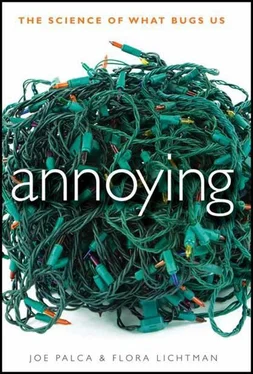One side of the maze piped out two-note consonant chords: an octave, “c” and “c”; a fifth, “c” and “g”, for example; a fourth, “c” and “f.” The other side played dissonant chords—minor seconds, tritones, and minor ninths. The monkeys showed no preferences between consonant and dissonant chords. Harvard undergrads, on the other hand, showed a clear preference for consonant sounds.
Even though the purpose of the experiment was to learn about music, McDermott was also curious whether tamarins would show a preference against the sound of fingernails on a chalkboard. He played the sound of fingernails on one branch and white noise from the other branch.
The cotton-top tamarins showed no significant preference for the white noise versus the scraping. They did, however, when given a volume option, choose to spend more time on the side of the maze with lower-volume white noise compared with higher-volume white noise.
This finding tempers Blake’s primate warning call theory. The tamarins didn’t seem to dislike the fingernail sound—meaning, at least, that these primates didn’t show a preference against it. McDermott offers another explanation for why we don’t like the sound of fingernails on a chalkboard. It’s rough on the ears. Roughness—remember from the buzzing fly or abrupt English elocution—is a technical term in acoustics that has to do with the amount of volume, or amplitude, modulation per second.
If you were to watch fingernails or garden tools running down slate with a high-speed camera, says David Huron, you would understand. “Your fingernail is grabbing the surface and then as you continue to move your hand down, it’s stuck to the board, and then all of a sudden it will slip and jump to the next position.” It’s called, Huron says, a “stick-slip sound production.” This produces a highly unpredictable, varied sound. “You get periods where it almost sounds like a whistle. And then there are periods where it becomes very rough—and those are the ones that tend to make people cringe the most,” says Josh McDermott.
Guitar players know roughness as beating. When you tune a guitar, you typically fret a string on its fifth fret and play the next string down. When the two notes are slightly out of tune, you hear the volume go up and down—kind of like wowuuuwowuuu. Those are the individual peaks and valleys in the waveform. The beating slows as the pitches approach each other and stops when the two pitches are perfectly in synch. “People don’t usually call that rough,” McDermott says. “Those are just beats.” As the pitches move farther apart, the beat frequency increases, and the sound will start to sound rough. When the notes are more than 20 Hz apart in frequency, McDermott says, you can’t hear the wowuuuwowuuu, and that’s roughness. Then when the beating goes up to 75 to 100 Hz, the roughness goes away—it’s too fast to resolve as rough.
Roughness has been scientifically proved to be annoying. {17} 17 6. J. Vos and G. F. Smoorenburg, “Penalty for Impulse Noise, Derived from Annoyance Ratings for Impulse and Road-Traffic Sounds,” Journal of the Acoustical Society of America 77(1) (1985): 193–201; T. Hashimoto and S. Hatano, “Roughness Level as a Measure for Estimating Unpleasantness: Modification of Roughness Level by Modulation Frequencies,” Proceedings of the Inter-Noise 94 Conference , Yokohama, Japan (1994): 887–892.
Car manufacturers, for instance, have done many studies on how to minimize annoying sounds generated by cars. “One of the biggest factors determining whether a sound will be annoying or not annoying is how smooth the amplitude envelope is,” McDermott says. The envelope is the shape of the amplitude of a sound over time. A rough envelope doesn’t look much like an envelope at all. It looks more like an accordion. If it has that accordion shape—if the volume goes up and down rapidly—the sound tends to annoy people. This might be a factor in why the fingernails-on-chalkboard sound is so annoying: it’s quite rough.
As for why we don’t like roughness, there’s no clear answer. McDermott says, “It’s a bit harder to say why sound roughness is considered unpleasant—as far as we know, it is not harmful to the ears.” David Huron suggests that we don’t like it because rough sounds interfere with our ability to hear, to pull information out of the environment.
The fingernail mystery remains unsolved—but the leads are helpful. Distracting, rough, ear preservation, adapted aversion: these are some of the theories for what makes certain sounds intrinsically unpleasant—explaining their widespread ability to annoy.
Smells may be the sneakiest of all annoyances. They’re invisible. They’re silent. You are aware of them only after it’s too late. And they’re powerful. Pleasant smells can transport you instantly to a memory of your grandmother’s kitchen or your favorite swimming hole. Unfortunately, unpleasant ones have the same effect.
When you consider that a ten-pound fur ball can ward off a nine-hundred-pound bear simply by suggesting that a bad smell is coming, you realize how powerful odors can be. Think of that for a moment. A porcupine went to the trouble of evolving a coat of razor-sharp spines, and that’s not as effective as a skunk’s primary weapon. Skunks command the forest through smelliness. The aerosol spray isn’t deadly, it’s annoying. It’s so annoying that it can repel almost everything, including much bigger, stronger, and faster predators. For skunks, being annoying means staying alive.
And skunks are deeply annoying. This is clear if you’ve ever had a dog get sprayed by a skunk. It smells terrible—obviously—and before you can bathe your dog, the scent will seemingly have penetrated every object in your house. Even professional groomers can’t completely eliminate the stink from a dog’s coat. Every time you think the odor is gone, it reappears. For days, when you (not your dog) go out wearing clothes that were never anywhere near the skunk or the dog, people will say, “Do you smell a skunk? I thought I caught just the faintest whiff of a skunk in here.”
Skunk spray looks sort of like pizza grease. It’s oily and an orange-yellow color. Skunks produce the spray in their anal glands and turn it into a weapon by shooting it in the direction of predators. Other carnivores, including ferrets, polecats, minks, and weasels, also have the odiferous oil, “but they don’t have the ability to aim and squirt it as skunks do,” says skunk expert Jerry Dragoo.
Skunks have even evolved special anal nipples for spraying! When a skunk feels threatened, “he’s going to aim those nipples, and it’s going to come out like a squirt gun,” says Dragoo, who has been squirted many times in the course of his career as a mephitologist. The term refers to the study of the family Mephitidae , of which skunks are the only members.
Dragoo says that even skunks appear to dislike the odor of skunk spray. This stink also poses a problem for anyone who thinks of becoming a mephitologist. Dragoo says that he can’t smell skunk spray, which may explain his career choice.
William Wood, one of the few chemists brave enough to study skunk spray, suggests that the annoying odor may be responsible for slow advances in the field of skunk spray research. In an article called “The History of Skunk Defensive Secretion Research,” published in the Chemical Educator , Wood wrote, “Skunks and their defensive secretion have both fascinated and repelled natural product chemists. The chemicals secreted by the members of the mephatinae , a New World subfamily of the weasel family ( Mustelidae ), are so obnoxious that few chemists have been willing to work with them.” {18} 18 1. William Wood, “The History of Skunk Defensive Secretion Research,” Chemical Educator 4 (1999): 44–50.
Читать дальше












